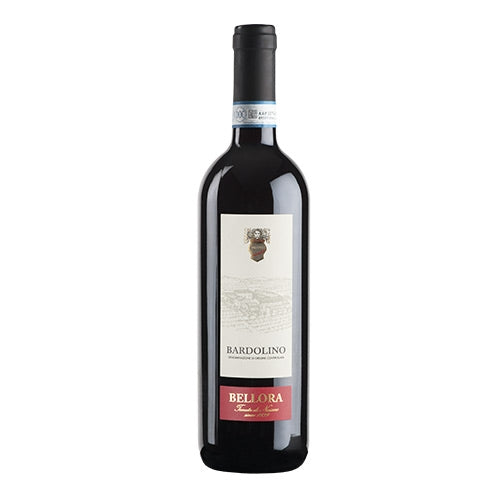Bellora Wine
"LE BARBERE" CLASSIC BARDOLINO DOC
Regular price
€10,50 EUR
Regular price
€12,00 EUR
Sale price
€10,50 EUR
Unit price
per
Tax included.
Couldn't load pickup availability
DESCRIPTION
Bardolino Classico DOC 2020 Le Barbere is produced in the hilly area of Lake Garda in morainic soils of fluvial-glacial origin. The Bardolino vines are therefore reflected in Lake Garda, a pre-Alpine environment that has the colors and scents of the Mediterranean with its mild climate, exposure to the sun and the variety of soils.
The Bardolino area occupies the Veneto sector of the morainic amphitheater of Lake Garda, formed by the glaciers that shaped the lake basin. The oldest finds referring to the use of wine in the current territory of Bardolino date back to the Roman era and are objects intended for religious rites (situle and pàtere) and for the conservation of wine (amphoras).
SENSORY DESCRIPTION
The violet reflections stand out on the intense ruby red color of the Bardolino DOC. The nose is dominated by small berries followed by characteristic spicy notes of pepper and dog rose. On the palate it is dry and harmonious and conquers for its elegance and juicy drinkability
HOW AND WHEN TO TASTE IT
The Bardolino Classico DOC 2020 Le Barbere goes very well with all types of pasta (with meat, fish, vegetable sauces), with risottos and even filled pastas such as ravioli. Excellent in legume soups and Venetian pasta and beans. It goes well with white and red meats. On Lake Garda, Bardolino is drunk with lake fish, for example, with risotto with tench or grilled eel. It is a wine to be tasted at a service temperature of 15-16 °C in a large glass.
WHERE AND HOW IT IS PRODUCED
Bardolino Classico DOC Le Barbere is made from the following grapes: Corvina Veronese 50%, Rondinella 35%, Molinara 15%. It is produced in Veneto, in the province of Verona, in the hilly area of Lake Garda in morainic soils of fluvial-glacial origin.
HARVEST
Manual, it takes place in the first half of September, with the soft pressing of the destemmed grapes.
FERMENTATION
It takes place in stainless steel tanks at a controlled temperature (26-30°C) for 8-10 days with daily pumping over. Malolactic fermentation in December. Permanence for about 3 months in steel tanks, refinement of 2 months in the bottle before being placed on the market.
Bardolino Classico DOC 2020 Le Barbere is produced in the hilly area of Lake Garda in morainic soils of fluvial-glacial origin. The Bardolino vines are therefore reflected in Lake Garda, a pre-Alpine environment that has the colors and scents of the Mediterranean with its mild climate, exposure to the sun and the variety of soils.
The Bardolino area occupies the Veneto sector of the morainic amphitheater of Lake Garda, formed by the glaciers that shaped the lake basin. The oldest finds referring to the use of wine in the current territory of Bardolino date back to the Roman era and are objects intended for religious rites (situle and pàtere) and for the conservation of wine (amphoras).
SENSORY DESCRIPTION
The violet reflections stand out on the intense ruby red color of the Bardolino DOC. The nose is dominated by small berries followed by characteristic spicy notes of pepper and dog rose. On the palate it is dry and harmonious and conquers for its elegance and juicy drinkability
HOW AND WHEN TO TASTE IT
The Bardolino Classico DOC 2020 Le Barbere goes very well with all types of pasta (with meat, fish, vegetable sauces), with risottos and even filled pastas such as ravioli. Excellent in legume soups and Venetian pasta and beans. It goes well with white and red meats. On Lake Garda, Bardolino is drunk with lake fish, for example, with risotto with tench or grilled eel. It is a wine to be tasted at a service temperature of 15-16 °C in a large glass.
WHERE AND HOW IT IS PRODUCED
Bardolino Classico DOC Le Barbere is made from the following grapes: Corvina Veronese 50%, Rondinella 35%, Molinara 15%. It is produced in Veneto, in the province of Verona, in the hilly area of Lake Garda in morainic soils of fluvial-glacial origin.
HARVEST
Manual, it takes place in the first half of September, with the soft pressing of the destemmed grapes.
FERMENTATION
It takes place in stainless steel tanks at a controlled temperature (26-30°C) for 8-10 days with daily pumping over. Malolactic fermentation in December. Permanence for about 3 months in steel tanks, refinement of 2 months in the bottle before being placed on the market.
Materials
Materials
Dimensions
Dimensions
Care information
Care information


